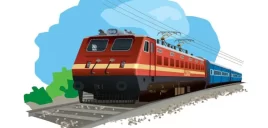GENERAL FEATURES OF 3-PHASE AC LOCO
Advanced Technological Features: – In addition to the provision of latest 3-phase traction drive system; the 3-phase locomotives have certain improved technical features as compared to the conventional locomotives so being used on IR. Some major features are listed below.
1) Digital electronics based real time traction control System: –
To obtain precise control over tractive effort and speed in the normal mode and constant speed control mode of operation respectively.
2)Electrical weight transfer control system:-
To automatically reduce the tractive effort in the leading bogie and increase the same in the trailing bogie to take care of weight transfer effect.
3)Anti spin protection: –
When the ratio of requested and effected tractive effort goes below 0.5, anti spin protection initiated, which reduce the TE and apply loco brakes to stop spinning.
4)On-board fault diagnostics system:-
To eliminate/ elaborate trouble-shooting by engine crew and also to help maintenance staff to trace faults. The fault diagnostics system provides for automatic isolation of faulty equipment/ subsystems.
5)Simulation mode of operation: –
To facilitate a complete functional testing of the locomotive without raising pantograph.
6)An exclusive harmonic filter circuit:-
To reduce harmonics in the loco current
7)Static auxiliary converter: –
To supply auxiliary 3-phase motors. The auxiliary converter, depending on the traction load, operates at an optimum frequency to minimize power consumed by auxiliaries
8)Electronic speedometer: –
Paperless speed recording system. An over speed alarm system is built in.
9)Electronic energy meter: – For information of energy generated and energy consumed
10)Fire detection and alarm system:-For the machine room.
11) Low traction bar arrangement between bogie and body to reduce weight transfer :- Unidirectional mounting of traction motors to further reduce weight transfer effect.
12) Ergonomically designed and spacious driving cabs: – To provide comfort and relief to crew.
13) Use of inertial filters: – Pressurized machine room to prevent entry of dust into sensitive equipment in the machine room.
14)Electronic brake system: – For precise and fast control of braking effort, blending between electrical brake and pneumatic brake on the locomotive.
15)Triplet pneumatic brake panel :-To minimize pipingand provide single- place location of all pneumatic equipment.
16) Use of tread brake units: -To reduce maintenance
17) Spring loaded parking brake system –
Instead of handbrakes, spring loaded parking brakes are provided on this loco, these brakes can be operated from loco and remain applied without pressure by spring.
18) Over-charge feature in the brake system for faster release of brakes –
For faster release of train brakes after recreation, BP is charged to 5.4 kg / cm2 for short time with restricted dropping rate to 5.0 kg/cm2.
19)Electronic controlled vigilance system –
To keep the loco pilot alert Vigilance system is provided, As per this system, loco pilot has to do predetermined task once within 60 seconds, otherwise VCD will apply emergency braking.
20)Wheel Flange lubrication system: –
To reduce energy consumption and wheel wear.
21)Under-slung compressors:-
To eliminate oil fumes and oil spillage inside the machine room, which is potential causes for fire hazards.
Advantages of 3-phase locomotives
The merits of 3-phase locomotives over D.C.-motored locomotives are summarized below.
1 -The size of traction motor for the same output power is much less in case of a 3-phase induction motor compared to DC motor. Therefore, with the permissible axle load and available space in a bogie, realization of a much higher-powered loco motive is possible.
2-Maintenance cost of a 3-phase locomotive is less due to absence of brush-gear/ commutator in the traction motors and switchgears in the power circuit.
3-Induction motors are very robust. Consequently reliability of a 3- phase locomotive is higher.
4 -The rated power of a D.C.-motored locomotive reduces beyond the field weakening range. In case of 3-phase loco motives, full power is available up to the maximum speed.
5-Overload capabilities in 3-phase locomotives are more Liberal.
6-Regeneration of power is available in 3-phase locomotives. Regenerative braking effort is available from the full speed till dead stop. Consequently, the overall efficiency of operation is higher.
7-Due to superior drop characteristics of speed Vs. torque and the fact that the motor speed is limited by the synchronous speed, a much improved adhesion is available in 3-phase locomotive and thus higher tractive efforts can be realized within permissible axle load limits.
8-3-phase locomotive operates at near unity power factor throughout the speed range except at very low speeds.
9-Due to lesser weight of the traction motors, the un-sprung masses in 3-phase locomotive are low. This reduces track forces and consequently minimizes wear on rails and disturbance to track geometry











